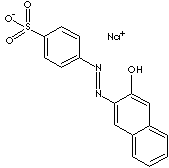PRODUCT IDENTIFICATION

D & C Orange No.4; Mandarin G; Orange(II), certified; Orange P; Orange R; Tropaeolin No2; Acid Orange A; Orange II;
c12c(\N=N\c3ccc(S(=O)(=O)[O-])cc3)c(ccc1cccc2)O.[Na+]
CLASSIFICATION
Acid Dye, Stain,
EXTRA NOTES
PHYSICAL AND CHEMICAL PROPERTIES
REFRACTIVE INDEX
EXTERNAL LINKS & GENERAL DESCRIPTION
Wikipedia Linking - Acid_orange 7
Google Scholar Search - C.I. Acid Orange 7
Drug Information Portal (U.S. National Library of Medicine) - C.I. Acid Orange 7
PubChem Compound Summary - C.I. Acid Orange 7
KEGG (Kyoto Encyclopedia of Genes and Genomes) - C.I. Acid Orange 7
http://www.ebi.ac.uk/ - C.I. Acid Orange 7
http://www.ncbi.nlm.nih.gov/ - C.I. Acid Orange 7
http://toxnet.nlm.nih.gov/
Hazardous
Substances Data Bank - C.I. Acid Orange 7
Local:
Acid dyes are water-soluble dyes employed mostly in the form of sodium salts of
the sulfonic or carboxylic acids. They are anionic which attach strongly to
cationic groups in the fibre directly. They can be applicable to all kind of
natural fibres like wool, cotton and silk as well as to synthetics like
polyesters, acrylic and rayon. But they are not substantive to cellulosic
fibres. They are also used in paints, inks, plastics and leather. Orange acid
azo dyes produce an orange-pink color. They are used in coloring foods and drugs
and as intermediates for making photosensive dyes and drugs. They are used as
counter stains in histology and cytology and as components of Mallory's acid
fuchsin. C.I. Acid Orange 7 (acid magenta) is a various mixture of sulfonated fuchsins.
There are four of these compounds which have three sulfonic groups each. It is
used in Andrade's indicator and in various complex stains to demonstrate
collagen fibres red and in smooth muscle in contrast to
collagen. It is used as a pH indicator.
Examples of orange acid dyes
- Ethyl orange Sodium salt ( CAS RN: 62758-12-7)
- Orange II ( CAS RN: 633-96-5)
- Orange III (methyl orange, CAS RN: 547-58-0)
- Orange IV (CAS RN: 554-73-4)
- Orange G ( CAS RN: 1936-15-8)
- Tropaeolin O (CAS RN: 547-57-9)
- Victoria orange
- Acid Orange II (Dibromofluorescein, 596-03-2)
APPEARANCE
100.0 ± 3.0%
MOISTURE
5.0% max
INSOLUBLES IN WATER
1.0% max
HAZARD OVERVIEW
Causes skin irritation. Causes serious eye irritation. May cause respiratory irritation.
GHS
PICTOGRAMS

HAZARD STATEMENTS
H315-H319-H335
P STATEMENTS
P261-P305 + P351 + P338
![]()
RISK PHRASES
36/37/38
SAFETY PHRASES
26
BIOLOGICAL STAINS, INDICATORS